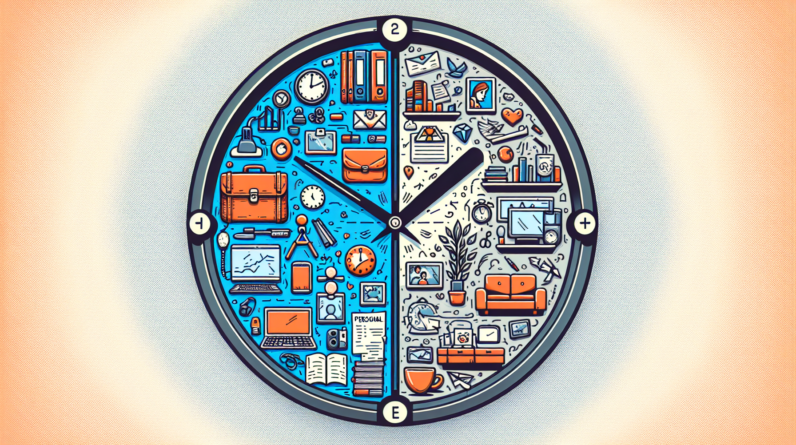
In today’s fast-paced world, maintaining a healthy work-life balance can often feel like a daunting task. As the demands of our professional and personal lives continue to grow, it becomes increasingly important to find a way to effectively juggle all of our responsibilities. Luckily, there are some tried-and-true tips that can help us navigate the intricacies of this delicate balancing act. Whether it’s setting boundaries, prioritizing self-care, or utilizing effective time management techniques, learning the art of juggling responsibilities is not only possible, but it can also lead to a more fulfilling and satisfying life.
Setting Priorities
Identify your core values
Setting priorities starts with understanding your core values. These are the fundamental beliefs and principles that guide your decisions and actions. Take some time to reflect on what truly matters to you in life. Is it family, career success, personal growth, or something else? Identifying your core values will help you gain clarity about what you want to prioritize in your work and personal life.
Determine your top priorities
Once you have a clear understanding of your core values, it’s time to determine your top priorities. These are the areas of your life where you want to invest the most time and energy. Consider the different aspects of your life, such as family, career, health, relationships, and personal growth. Rank them in order of importance and focus on allocating your resources accordingly. By identifying your top priorities, you can make conscious choices and avoid getting overwhelmed by competing demands.
Learn to say no
Saying no can be difficult, especially when you want to be helpful or avoid disappointing others. However, learning to say no is essential for maintaining a healthy work-life balance. Set clear boundaries and don’t hesitate to decline requests or opportunities that don’t align with your priorities. Remember, saying no isn’t selfish; it’s about protecting your time and energy so that you can focus on what truly matters to you.
Time Management
Create a schedule
Creating a schedule is a crucial time management technique. Start by assessing your commitments and obligations, both at work and in your personal life. Then, allocate dedicated time slots for each task or activity. A well-structured schedule helps you stay organized, keeps you on track, and ensures that you have time for everything that matters to you. Use tools and apps to manage your schedule effectively and make adjustments when necessary.
Take breaks and rest
While it may seem counterintuitive, taking regular breaks and allowing yourself time to rest can actually improve your productivity and overall well-being. Research shows that short breaks throughout the day can help you maintain focus and prevent burnout. Incorporate short breaks, exercise, and relaxation activities into your daily routine. Remember, rest is not a reward for working hard; it’s a vital part of maintaining a healthy work-life balance.
Use time-saving techniques
In today’s fast-paced world, finding ways to save time can make a significant difference in achieving work-life balance. Use time-saving techniques such as prioritizing tasks, reducing distractions, automation, and delegation whenever possible. Learn to streamline your work processes and eliminate unnecessary activities. By being intentional with your time and optimizing your efficiency, you can create more room for the things that truly matter.
Effective Communication
Set clear expectations
Effective communication is key to maintaining work-life balance. Set clear expectations with your colleagues, supervisors, and loved ones about your availability, boundaries, and priorities. Make sure everyone is on the same page regarding deadlines, expectations, and responsibilities. When everyone understands what is expected, it becomes easier to manage your time and maintain a healthy balance between work and personal life.
Delegate and collaborate
Don’t be afraid to delegate tasks and collaborate with others. Delegating responsibilities at work and at home can help lighten your workload and free up time for more important things. Identify tasks that can be done by someone else and empower them to take ownership. Collaboration also allows you to leverage other people’s expertise and skills, leading to better outcomes and shared responsibilities.
Practice active listening
Active listening is a crucial skill that improves both professional and personal relationships. When you actively listen, you give your full attention to the person speaking, seeking to understand their perspective and feelings. By practicing active listening, you foster Effective communication, build stronger connections, and reduce misunderstandings. It also helps you manage your time better by avoiding unnecessary conflicts and resolving issues more efficiently.
Managing Stress
Recognize your stress triggers
Stress is a common part of life, but understanding your stress triggers can help you manage it more effectively. Take the time to identify the situations, people, or tasks that consistently cause you stress. Once you recognize these triggers, you can develop strategies to cope with them better. This may involve setting boundaries, seeking support, or finding healthier ways to respond to stressors.
Practice self-care
self-care is essential for maintaining your well-being and managing stress. Take time to prioritize your physical, mental, and emotional needs. Engage in activities that bring you joy and help you relax. Whether it’s taking a bubble bath, practicing yoga, reading a book, or spending time in nature, find what nourishes your soul and make it a regular part of your routine. Remember, self-care isn’t selfish; it’s necessary for you to show up as your best self in all aspects of your life.
Utilize stress management techniques
When stress becomes overwhelming, it’s important to have tools and techniques to manage it. Explore different stress management techniques, such as deep breathing exercises, meditation, journaling, or engaging in hobbies. These techniques can help you calm your mind, reduce stress levels, and regain balance. Experiment with different practices and find what works best for you in relieving stress and maintaining your well-being.

Maintaining Boundaries
Separate work and personal life
Maintaining boundaries between your work and personal life is crucial for achieving work-life balance. Clearly define your work hours and strive to stick to them. Avoid bringing work-related tasks into your personal time and vice versa. Create physical and mental separation between your work and living spaces, if possible. By establishing clear boundaries, you can fully engage and be present in both areas of your life without feeling overwhelmed or constantly distracted.
Establish boundaries with colleagues
It’s important to establish boundaries with your colleagues to ensure that work commitments don’t encroach on your personal time. Clearly communicate your availability and preferred methods of communication. Set realistic expectations for response times, especially during non-working hours. By setting boundaries with your colleagues, you can maintain a healthy division between work and personal life, reducing stress and enhancing overall well-being.
Set technology boundaries
Technology has made it easier to stay connected, but it also blurs the lines between work and personal life. Establish technology boundaries by designating specific times to check emails or respond to work-related messages. Consider turning off notifications during non-working hours to minimize distractions and create space for personal activities. Being intentional about when and how you engage with technology can help you maintain a healthier work-life balance.
Finding Work-Life Integration
Discover flexible work options
Work-life integration involves finding ways to blend your work and personal life in a way that works for you. Explore flexible work options, such as remote work, flexible hours, or compressed workweeks. These arrangements can give you more control over your schedule and allow you to balance work and personal responsibilities more effectively. Talk to your employer about potential opportunities for flexible work arrangements that align with your needs.
Find hobbies and activities you enjoy
Finding hobbies and activities that you enjoy is crucial for work-life integration. Engaging in activities outside of work not only provides a break from routine but also nurtures your personal interests and passions. Whether it’s painting, playing a sport, gardening, or cooking, invest time in activities that bring you joy. These pursuits can help you recharge, enhance creativity, and create a fulfilling and balanced life.
Invest in personal development
Personal development is vital for achieving work-life integration. Continuously investing in your knowledge and skills helps you grow both personally and professionally. Seek out opportunities for learning, whether it’s attending workshops, taking online courses, or reading books. By investing in personal development, you expand your horizons, gain new perspectives, and become more adaptable, ultimately contributing to a more harmonious work-life balance.

Building a Support System
Seek support from family and friends
Building a strong support system is essential for maintaining work-life balance. Lean on your family and friends for emotional support, understanding, and encouragement. Communicate your needs and challenges to them, and don’t hesitate to ask for help when needed. Having a support network can provide you with a sense of belonging, reduce stress, and provide valuable insights and perspectives.
Connect with like-minded individuals
Connecting with like-minded individuals who share similar values and goals can be invaluable in your quest for work-life balance. Seek out communities, both online and offline, where you can connect with people who understand your journey and can offer support and guidance. Whether it’s joining professional organizations, attending networking events, or participating in social groups, surrounding yourself with like-minded individuals can foster a sense of camaraderie and help you navigate the challenges of balancing responsibilities.
Consider professional support
Sometimes, professional support can be beneficial in maintaining work-life balance. Consider seeking guidance from therapists, coaches, or mentors who specialize in work-life balance or stress management. These professionals can provide valuable tools, strategies, and insights tailored to your specific circumstances. They can help you navigate challenges, overcome obstacles, and develop a personalized plan for achieving optimal work-life balance.
Fostering Work-Life Balance in the Workplace
Promote work-life balance policies
Employers have a role to play in fostering work-life balance for their employees. Promoting and implementing work-life balance policies, such as flexible work hours, remote work options, and wellness programs, can have a profound impact on employees’ overall well-being and job satisfaction. Encourage your employer to adopt these policies or advocate for their implementation if you have the opportunity.
Encourage a healthy work culture
Creating a healthy work culture is essential for work-life balance. Encourage open communication, collaboration, and respect among colleagues. Promote a culture that values work-life balance and supports employees in achieving it. Recognize and appreciate individuals who prioritize their well-being and encourage others to do the same. By fostering a healthy work culture, organizations can create an environment where employees thrive both personally and professionally.
Offer flexible work arrangements
Flexible work arrangements, such as compressed workweeks, reduced hours, or job sharing, can significantly contribute to work-life balance. Employers should strive to offer these options whenever feasible. By providing employees with the flexibility they need to manage their work and personal responsibilities, organizations can enhance productivity, job satisfaction, and employee retention.

Maintaining Health and Well-being
Prioritize physical exercise
Physical exercise is essential for maintaining overall health and well-being. Make time for regular exercise, whether it’s going to the gym, practicing yoga, or engaging in outdoor activities. Regular physical activity can boost your energy levels, reduce stress, improve sleep quality, and enhance your overall mood. Incorporate exercise into your routine and make it a non-negotiable part of your work-life balance journey.
Eat a balanced diet
Eating a balanced diet is crucial for fueling your body and maintaining optimal health. Prioritize nutritious and wholesome foods that provide you with the energy and nutrients you need to stay focused and productive. Avoid excessive consumption of processed foods, sugary snacks, and caffeine, as they can lead to energy crashes and negatively impact your well-being. Remember to listen to your body’s hunger and fullness cues, and nourish yourself with foods that make you feel good.
Practice mindfulness and relaxation techniques
Mindfulness and relaxation techniques can help you quiet your mind, reduce stress, and improve overall well-being. Incorporate practices such as meditation, deep breathing exercises, or mindfulness-based activities into your daily routine. These practices can help you stay present, increase self-awareness, and improve your ability to respond to challenging situations with calmness and clarity. By cultivating mindfulness and relaxation, you enhance your capacity to maintain work-life balance and prioritize your well-being.
Overcoming Guilt
Accept imperfections
Perfectionism often leads to feelings of guilt and self-doubt. Accept that you are human and that it’s impossible to excel in every aspect of your life simultaneously. Embrace imperfections and recognize that they are part of the journey toward work-life balance. Allow yourself to make mistakes and learn from them. By accepting imperfections, you free yourself from unnecessary guilt and create space for growth and self-compassion.
Distinguish between guilt and responsibility
It’s important to distinguish between healthy responsibility and unnecessary guilt. Guilt may arise when you feel you aren’t meeting all the expectations or demands placed upon you. However, not every obligation or request is your responsibility. Learn to evaluate whether your guilt is warranted based on your core values and priorities. Focus on fulfilling your responsibilities rather than constantly trying to meet everyone else’s expectations, and release yourself from unnecessary guilt.
Practice self-compassion
Self-compassion is vital in overcoming guilt and maintaining work-life balance. Be kind to yourself and treat yourself with the same compassion and understanding you would extend to a loved one. When you make mistakes or experience challenges, remind yourself that it’s all part of your growth journey. Practice self-care, self-acceptance, and self-forgiveness. By cultivating self-compassion, you create a nurturing and supportive environment for yourself, promoting overall well-being and work-life balance.
In conclusion, achieving work-life balance is a continuous journey that requires identifying your core values, setting priorities, and maintaining healthy boundaries. By implementing effective time management techniques, practicing effective communication, managing stress, and prioritizing self-care, you can create a harmonious integration of work and personal life. Building a strong support system, both personally and professionally, and fostering a work culture that values work-life balance are crucial steps in achieving this equilibrium. Remember to prioritize your health and well-being, overcome guilt by accepting imperfections and practicing self-compassion, and invest in personal development. Embrace the art of juggling responsibilities, and with dedication and perseverance, you can achieve a fulfilling and balanced life.







